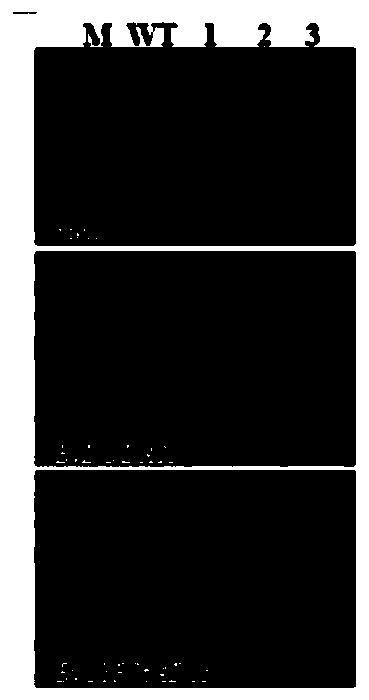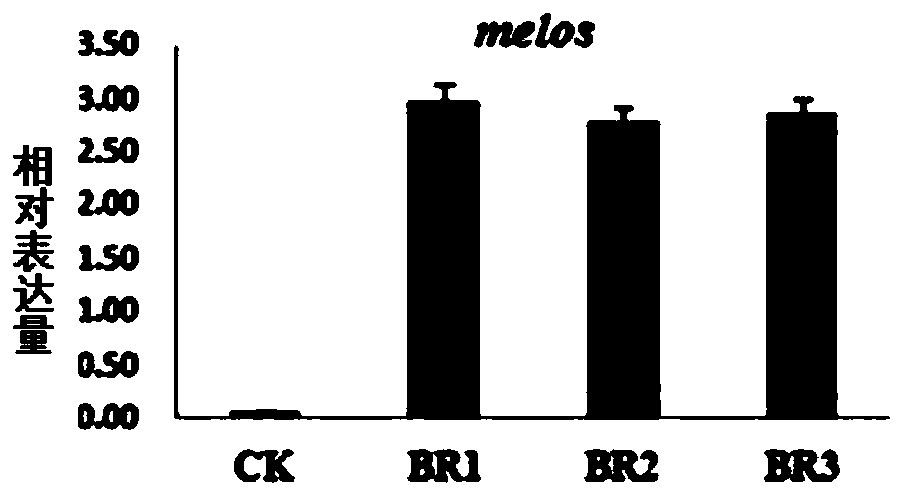Gene combination for producing betaine by expression in rice seed endosperm and application thereof
A technology of rice seeds and betaine, which is applied in the field of genetic engineering, can solve the problems affecting the production of betalain in beet, etc.
- Summary
- Abstract
- Description
- Claims
- Application Information
AI Technical Summary
Problems solved by technology
Method used
Image
Examples
Embodiment 1
[0047] 1. Three-segment gene optimization design and synthesis
[0048] Optimization is carried out according to the following principles: (1) optimize gene codons, improve gene translation efficiency according to rice codon preference; (2) eliminate the recognition sites of commonly used restriction endonucleases inside genes, and facilitate the construction of expression cassettes; (3) ) Eliminate inverted repeat sequence, stem-loop structure and transcription termination signal, balance the GC / AT inside the gene, and improve the stability of RNA; (4) make the gene-encoded protein conform to the N-terminal principle, so as to improve the stability of the translated protein; ( 5) Optimize the free energy of the secondary structure of mRNA to improve the efficiency of gene expression.
[0049] Using the melo gene (GenBank No.D37929.1) of Aspergillus oryzae as a template, according to the rice codon preference, the meloS gene with the DNA sequence shown in SEQ ID NO.1 was optim...
Embodiment 2
[0065] Embodiment 2 identification transgenic rice
[0066] 1. PCR detection of transformed plant genomic DNA
[0067] The genome is extracted from the mature seeds obtained in Example 2, and the genomic DNA is used as a template to detect exogenous genes meloS, BvDODA1S and BvCYP76AD1S using specific primers. The specific sequences of the primers used are as follows:
[0068] meloSZ: Atggcatctgttgaaccaatc;
[0069] meloSF:ttaacgcatagtaccaacagt;
[0070] BvDODA1SZ: atgaagatgattgaatggtgaa;
[0071] BvDODA1SF: ttaagcagaggtgaacttgta;
[0072] BvCYP76AD1SZ: atggatcatgcaactttggca;
[0073] BvCYP76AD1SF: ttagtaacgtgggattggaat.
[0074] Amplification program used: 94°C for 30s, 54°C for 30s, 72°C for 120s, a total of 45 cycles, and finally 72°C for another 10min. For the results, see figure 2 .
[0075] figure 2 The results showed that the wild-type (WT) control could not amplify the exogenous gene, but the vector carrying the three genes was stable, and the exogenous gene ...
Embodiment 3
[0086] Embodiment 3 Appearance observation and betaine content detection of transgenic rice seeds
[0087] The transgenic rice seeds were harvested when they were fully mature and dried in the field. After shelling, the color of the rice seeds was observed with the naked eye. By observing the appearance of the transgenic rice seeds and wild-type seeds, it can be clearly seen that the ratio of the transgenic rice seeds with the three genes Wild-type rice seeds had a darker color ( Figure 6 ).
[0088] Extraction and high-performance liquid chromatography (HPLC) identification of transgenic rice seed betaine: take 0.1g rice seed and grind it into powder on ice, add 2mL methanol and continue to grind uniformly for 5min; ) for 10 minutes; centrifuge at 8000 rpm at 4°C for 5 minutes to collect the supernatant; repeat the extraction of the precipitate until the precipitate is white;
[0089] The supernatant was centrifuged at 8000rpm at 4°C for 5 minutes and combined, and the col...
PUM
| Property | Measurement | Unit |
|---|---|---|
| wavelength | aaaaa | aaaaa |
Abstract
Description
Claims
Application Information
 Login to View More
Login to View More - R&D
- Intellectual Property
- Life Sciences
- Materials
- Tech Scout
- Unparalleled Data Quality
- Higher Quality Content
- 60% Fewer Hallucinations
Browse by: Latest US Patents, China's latest patents, Technical Efficacy Thesaurus, Application Domain, Technology Topic, Popular Technical Reports.
© 2025 PatSnap. All rights reserved.Legal|Privacy policy|Modern Slavery Act Transparency Statement|Sitemap|About US| Contact US: help@patsnap.com



